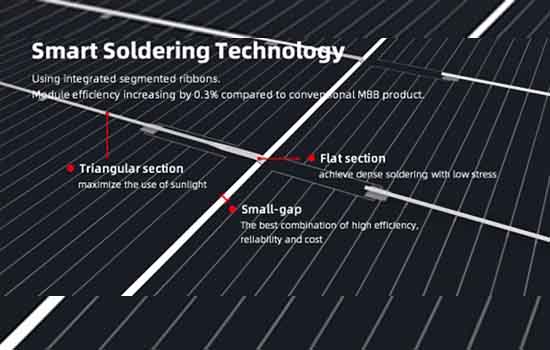LONGi has issued a white paper on its proprietary “Smart Soldering” technology, applied in its new-generation Hi-MO 5 series high-power 182mm modules. With the ongoing volume application of large-format PV modules in utility-scale plants, the unique technology can guarantee their loading capacity, enabling energy yield to be optimized throughout their whole lifecycle, delivering more value-added benefits to global investors in power plants, partners and customers.
It is generally accepted that the introduction of high-efficiency modules can improve PV installed capacity in a limited space, reducing both the investment required in system materials and equipment and the use of resources such as glass or EVA, which underlines why optimizing conversion efficiency remains a long-term aim for PV technology development.
In recent years, in addition to improvements in cell efficiency, the conversion efficiency of the PV module has also been increased via technologies such as “half-cut” and “multi-busbar” (MBB). The efficiency improvement in modules has been largely based on three elements – the improvement in optical efficiency, the reduction in electrical loss and the optimization of size. Half-cut and MBB technologies can reduce ribbon current to cut down electrical loss inside the module, the circular ribbon used in MBB technology providing higher optical efficiency than flat ribbon, the optical efficiency of a monofacial module being further enhanced with white EVA-encapsulated bifacial cells. In terms of module size, the gap between cells is continually being narrowed due to developments in process accuracy, the technology based on a shingled layout enabling a zero micro gap between cells having already emerged in the market. Half-cut and MBB technologies, as the mainstream options presenting the highest level of maturity in the market, are continually being upgraded in order to narrow or even eliminate cell gap architecture. LONGi unveiled its proprietary Smart Soldering technology in June 2020, with the launch of the 182mm Hi-MO 5, a product designed for the grid parity era, combining efficiency, power, reduced BOS cost and reliability.
What is Smart Soldering Technology?
By using segmented ribbon, it is possible to maximize use of sunlight on the front side of a module through the triangular section, achieving a more reliable cell interconnection with micro gap architecture. Testing has proven that, with Smart Soldering technology, module efficiency can be improved by 0.3% in comparison with conventional MBB technology.
During the module manufacturing process, the main technical difficulties of minimizing or eliminating the gap between interconnected cells involved maintaining accuracy and avoiding cracking. It was obviously a challenge to overcome the problem with conventional circular ribbon, so “circular shaping ribbon” entered the market, whereby the ribbon interconnecting the cells was flattened during the cell soldering process.
With circular shaping ribbon technology, cells could be interconnected in a shingled layout, achieving higher density in packing. There were still disadvantages, however. Even though the ‘sandwich’ structure was adopted, micro cracks could appear at the joint and could increase during the lifecycle of the module. In other words, improvements in this technology could result in a decrease in module reliability, with the shingled part of the cells unable to generate electricity while, in order to avoid cracks, the cells needed to be encapsulated with thicker EVA. All these factors could significantly increase module costs.
Then the solution of circular shaping ribbon interconnecting cells with a small gap was developed. Although in comparison with the previous solution, a high increase in cost was avoided, it was even more difficult to maintain the gap between cells, with micro cracks at the joint still a possibility.
The Smart Soldering technology developed by LONGi uses integrated segmented ribbon with a small gap connection. The ribbon is softened by an annealing process and internal stress is eliminated, enabling both higher manufacturing yield and reliability. The small gap connection achieved avoids micro cracks.
Moreover, as for optical efficiency, triangular ribbon features a higher utilization rate for direct light than circular one, and also realizes the use of primary reflected light other than secondary reflected light (indirect light), with a lower efficiency loss than the circular ribbon at various angles of incidence. Therefore, triangular ribbon is superior in energy yield.
Reliability Test for “Smart Soldering” Technology
The integrated segmented ribbon is softly connected. On the one hand, significant deformation can be prevented during soldering and lamination thanks to the flat section between cells. On the other hand, the segmented ribbon is integrated, with internal stress eliminated by the annealing process, thereby realizing a lower yield strength than with circular shaping ribbon. The technology reduces the tensile stress of the cells, avoiding micro cracks. In bending tests, fractures appeared after smart soldering only after being bent 90° 20 times, while the circular shaping equivalent displayed fractures after only 7. Lamination verification showed that when both ribbons were encapsulated in a sample (cells with small-gap connection), micro cracks appeared with the circular shaping ribbon, while the integrated segmented alternative remained intact.
In order to further test the advantages of Smart Soldering technology in terms of reliability, LONGi’s technical team encapsulated three types of 182mm modules with Smart Soldering technology, circular shaping ribbon and conventional circular ribbon respectively, and conducted dynamic mechanical load (DML), static mechanical load (SML) and sequential testing. All test results showed that modules with Smart Soldering technology had the lowest level of power degradation. Sequential testing was conducted according to “SML→DML→thermal cycle,” which is closer to the actual operating environment during the lifecycle of a module. Results indicated that the power degradation rate of the module with circular shaping ribbon was 4.95%, with 9 cells seen to have major cracks. The degradation rate of the module with conventional MBB technology was 6.65%, with transverse cracks covering a broader area, while the degradation rate of the module using Smart Soldering technology was only 2.90%.
LONGi has adhered to its brand concept of “Steadfast and Reliable Technology Leadership.” By releasing its Smart Soldering technology, LONGi’s aim is to improve efficiency and reliability through the whole lifecycle of a PV module, along with half-cut and MBB technologies. With the increasing application of large-formart PV modules, the unique nature of the Smart Soldering technology will practically guarantee their loading capacity, enabling energy output to be increased and more benefits to be delivered to customers globally, contributing to the achievement of carbon neutrality goals.













